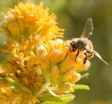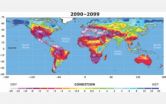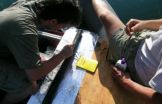(Press-News.org) Scientists at The Montreal Neurological Institute and Hospital – The Neuro, McGill University have discovered that our brains have the ability to determine the shape of an object simply by processing specially-coded sounds, without any visual or tactile input. Not only does this new research tell us about the plasticity of the brain and how it perceives the world around us, it also provides important new possibilities for aiding those who are blind or with impaired vision.
Shape is an inherent property of objects existing in both vision and touch but not sound. Researchers at The Neuro posed the question 'can shape be represented by sound artificially?' "The fact that a property of sound such as frequency can be used to convey shape information suggests that as long as the spatial relation is coded in a systematic way, shape can be preserved and made accessible - even if the medium via which space is coded is not spatial in its physical nature," says Jung-Kyong Kim, PhD student in Dr. Robert Zatorre's lab at The Neuro and lead investigator in the study.
In other words, similar to our ocean-dwelling dolphin cousins who use echolocation to explore their surroundings, our brains can be trained to recognize shapes represented by sound and the hope is that those with impaired vision could be trained to use this as a tool. In the study, blindfolded sighted participants were trained to recognize tactile spatial information using sounds mapped from abstract shapes. Following training, the individuals were able to match auditory input to tactually discerned shapes and showed generalization to new auditory-tactile or sound-touch pairings.
"We live in a world where we perceive objects using information available from multiple sensory inputs," says Dr. Zatorre, neuroscientist at The Neuro and co-director of the International Laboratory for Brain Music and Sound Research. "On one hand, this organization leads to unique sense-specific percepts, such as colour in vision or pitch in hearing. On the other hand our perceptual system can integrate information present across different senses and generate a unified representation of an object. We can perceive a multisensory object as a single entity because we can detect equivalent attributes or patterns across different senses." Neuroimaging studies have identified brain areas that integrate information coming from different senses – combining input from across the senses to create a complete and comprehensive picture.
The results from The Neuro study strengthen the hypothesis that our perception of a coherent object or event ultimately occurs at an abstract level beyond the sensory input modes in which it is presented. This research provides important new insight into how our brains process the world as well as new possibilities for those with impaired senses.
INFORMATION:
The study was published in the journal Experimental Brain Research. The research was supported by grants from the Canadian Institutes of Health Research and the Natural Sciences and Engineering Research Council of Canada.
About the Montreal Neurological Institute and Hospital
The Montreal Neurological Institute and Hospital — The Neuro, is a unique academic medical centre dedicated to neuroscience. The Neuro is a research and teaching institute of McGill University and forms the basis for the Neuroscience Mission of the McGill University Health Centre. Founded in 1934 by the renowned Dr. Wilder Penfield, The Neuro is recognized internationally for integrating research, compassionate patient care and advanced training, all key to advances in science and medicine. Neuro researchers are world leaders in cellular and molecular neuroscience, brain imaging, cognitive neuroscience and the study and treatment of epilepsy, multiple sclerosis and neuromuscular disorders. The Montreal Neurological Institute was named as one of the Seven Centres of Excellence in Budget 2007, which provided the MNI with $15 million in funding to support its research and commercialization activities related to neurological disease and neuroscience.
See no shape, touch no shape, hear a shape?
A new way of seeing the world
2010-10-20
ELSE PRESS RELEASES FROM THIS DATE:
Sniffing out shoe bombs: A new and simple sensor for explosive chemicals
2010-10-20
CHAMPAIGN, Ill. — University of Illinois chemists have developed a simple sensor to detect an explosive used in shoe bombs. It could lead to inexpensive, easy-to-use devices for luggage and passenger screening at airports and elsewhere.
Triacetone triperoxide (TATP) is a high-powered explosive that in recent years has been used in several bombing attempts. TATP is easy to prepare from readily available components and has been difficult to detect. It defies most standard methods of chemical sensing: It doesn't fluoresce, absorb ultraviolet light or readily ionize.
The ...
Old bees' memory fades; mirrors recall of mammals
2010-10-20
A study published Oct. 19 in the open access journal Public Library of Science (PLoS) ONE, shows that not just human memories fade. Scientists from Arizona State University and the Norwegian University of Life Sciences examined how aging impacts the ability of honey bees to find their way home.
While bees are typically impressive navigators, able to wend their way home through complex landscapes after visits to flowers far removed from their nests, the study reveals that aging impairs the bees' ability to extinguish the memory of an unsuitable nest site even after the ...
Drought may threaten much of globe within decades
2010-10-20
The United States and many other heavily populated countries face a growing threat of severe and prolonged drought in coming decades, according to results of a new study by National Center for Atmospheric Research (NCAR) scientist Aiguo Dai.
The detailed analysis concludes that warming temperatures associated with climate change will likely create increasingly dry conditions across much of the globe in the next 30 years.
The drought may reach a scale in some regions by the end of the century that has rarely, if ever, been observed in modern times.
Using an ensemble ...
Study reveals superior sedation method for children
2010-10-20
Procedural sedation and analgesia is an essential element of care for children requiring painful procedures in the emergency department. The practice of combining ketamine and propofol, two common medications used in emergency departments, has become more popular. However, until recently, it was unclear whether this practice was superior to the use of either agent alone, especially in children.
Research led by Drs. Amit Shah, Gregory Mosdossy and Michael Rieder of the Schulich School of Medicine & Dentistry at The University of Western Ontario and Lawson Health Research ...
Iowa State, USDA researchers discover eye test for neurological diseases in livestock
2010-10-20
AMES, Iowa – The eyes of sheep infected with scrapie – a neurological disorder similar to mad cow disease – return an intense, almost-white glow when they're hit with blue excitation light, according to a research project led by Iowa State University's Jacob Petrich.
The findings suggest technologies and techniques can be developed to quickly and noninvasively test for transmissible spongiform encephalopathies, progressive and fatal neurological diseases such as mad cow disease in cattle and Creutzfeldt-Jakob disease in humans. Petrich, in fact, is working to develop ...
Old logging practices linked to high erosion rates
2010-10-20
Clear-cut logging and related road-building in the 1950s and 1960s in southern Oregon's Siskiyou Mountains disrupted soil stability and led to unprecedented soil erosion made worse during heavy rainstorms, report University of Oregon researchers.
While logging practices have improved dramatically since then, the damaged landscape -- the removal of low vegetation that helps to protect hillsides during fires and rain -- continues to pose a threat into the foreseeable future, said Daniel G. Gavin, professor of geography, and postdoctoral doctoral researcher Daniele Colombaroli.
Their ...
The hair brush that reads your mind
2010-10-20
WASHINGTON, Oct. 19 – One of the main techniques for measuring and monitoring mental activity, called functional near infrared spectroscopy (fNIRS), can often be impaired because a person's hair gets in the way. But now, thanks to a team of researchers at the University of Texas at Dallas and the University of Texas at Arlington, a novel device called a "brush optrode" is providing increased sensitivity with fiber tips designed to thread through hair to enhance scalp contact.
Details of the device will be presented at the Optical Society's (OSA) 94th annual meeting, ...
Researchers advocate for more education and attention regarding rare breast cancer
2010-10-20
PHILADELPHIA (October 19, 2010)—Inflammatory breast cancer (IBC), an aggressive and rare malignancy, is often initially misdiagnosed as an infection or rash. However, getting the correct diagnosis quickly is critical for patients because the disease spreads beyond the breast in a matter of just days or weeks. With that in mind, leading specialists from The University of Texas MD Anderson Cancer Center and Fox Chase Cancer Center have written a review of the current scientific and medical understanding of IBC, which includes key information on diagnosis, imaging, treatment, ...
ORNL's research reactor revamps veteran neutron scattering tool
2010-10-20
OAK RIDGE, Tenn., Oct. 19, 2010 -- The Cold Triple Axis spectrometer, a new addition to Oak Ridge National Laboratory's High Flux Isotope Reactor and a complementary tool to other neutron scattering instruments at ORNL, has entered its commissioning phase.
The CTAX uses "cold" neutrons from the HFIR cold source to study low-energy magnetic excitations in materials. Cold neutrons are slower than their "thermal" neutron counterparts, and thus perfect for probing low-energy dynamics.
The instrument, which moves by way of air pads on an epoxy surface known as the "dance ...
Study: Religious diversity increases in America, yet perceptions of Christian nation intensify
2010-10-20
WEST LAFAYETTE, Ind. - While America continues to become more religiously diverse, the belief that America is a Christian nation is growing more intense, according to research from Purdue University.
"America is still predominantly Christian, but it is more diverse than ever," said Jeremy Brooke Straughn, an assistant professor of sociology who studies national identity. "At the same time, many people feel even more strongly that America is a Christian country than they did before the turn of the century. This is especially true for Americans who say they are Christians ...
LAST 30 PRESS RELEASES:
For teens, any cannabis use may have impact on emotional health, academic performance
School meals could unlock major gains for human and planetary health
Menopause hormone therapy does not appear to impact dementia risk
Signature patterns of brain activity may help predict recovery from traumatic brain injury
Dresden study uncovers new key mechanism in cancer cells
New species are now being discovered faster than ever before, study suggests
Cannabis-based products show limited short-term benefit for chronic pain, with increased risk of adverse effects
Cannabis products with more THC slightly reduce pain but cause more side effects
Clearing the brain of aging cells could aid epilepsy and reduce seizures
Brain injuries linked with potential risk of suicide, new study finds
New technique lights up where drugs go in the body, cell by cell
New study finds movement of fishing fleets can reveal shifts in marine ecosystems
Embargoed: New evidence points to potential treatment for vascular dementia
Study uncovers disrupted brain balance in alcohol dependence
Working in groups can help Republicans and Democrats agree on controversial content moderation online
Structural findings reveal how distinct GPCR ligands create different levels of activation
Anything-goes “anyons” may be at the root of surprising quantum experiments
UC review: Maximizing workplace opportunity for veterans
From generation to complex control: Metasurfaces make perfect vortex beams "within reach"
Thin-film lithium niobate-based detector: recent advances and perspectives
Exploring why some people may tend to persistently make bad choices
How cells balance their protein levels
Nirsevimab vs RSVpreF vaccine for RSV–related hospitalization in newborns
Effectiveness and impact of maternal RSV immunization and nirsevimab on medically attended RSV in US children
AI gives scientists a boost, but at the cost of too many mediocre papers
Next-generation vision model maps tree growth at sub-meter precision
Genes aren’t destiny for inherited blindness, study shows
MIT study: High-fat diets make liver cells more likely to become cancerous
Exposure to multiple fine particulate matter components and incident depression in the US Medicare population
Risk of burdensome health care spending over time in the US
[Press-News.org] See no shape, touch no shape, hear a shape?A new way of seeing the world



